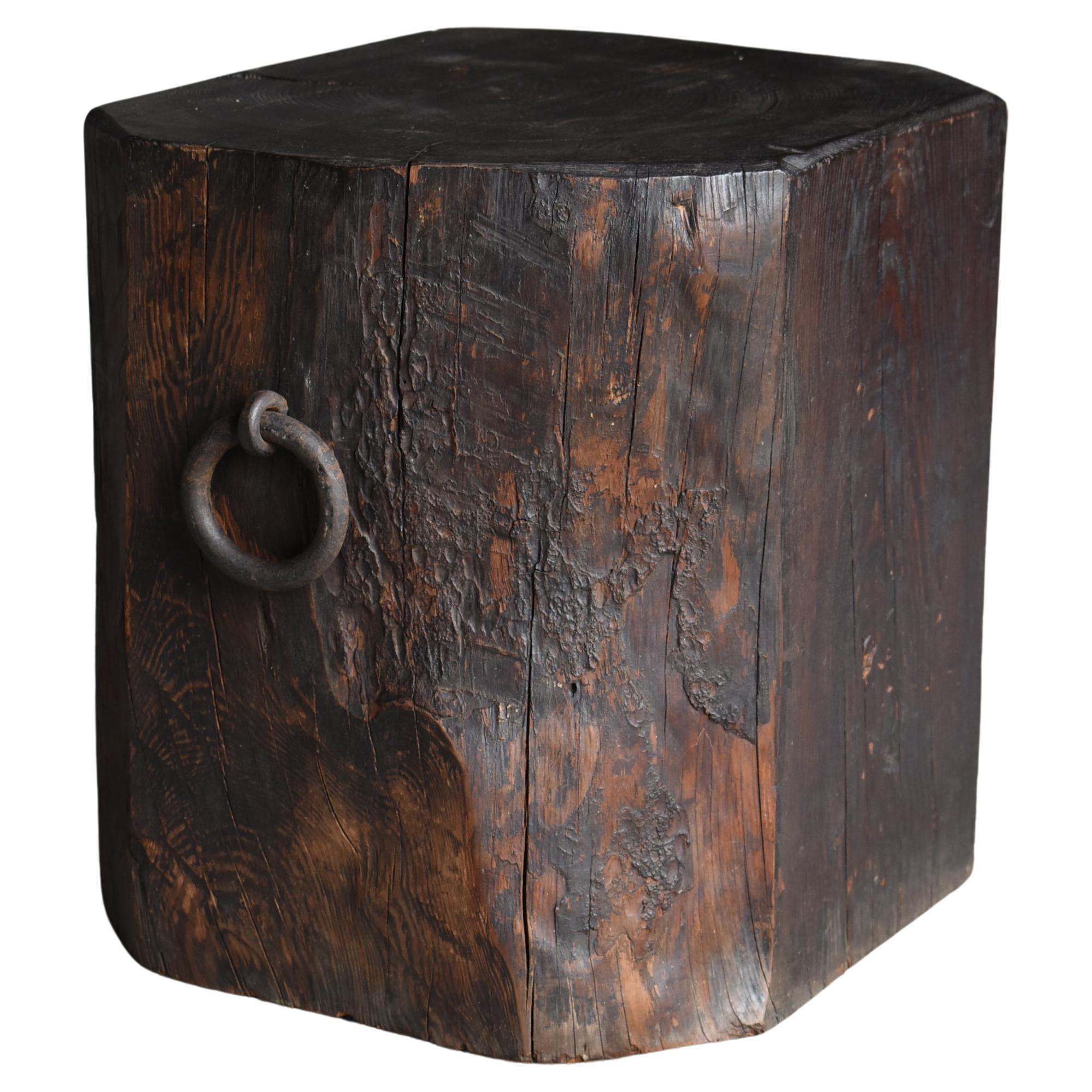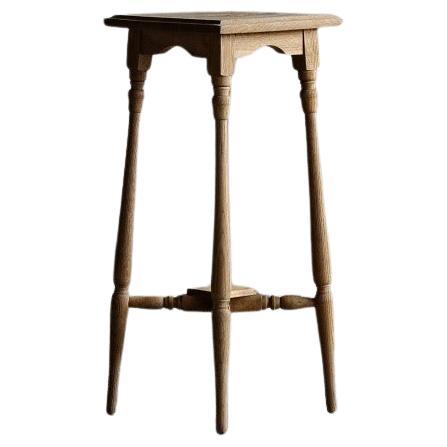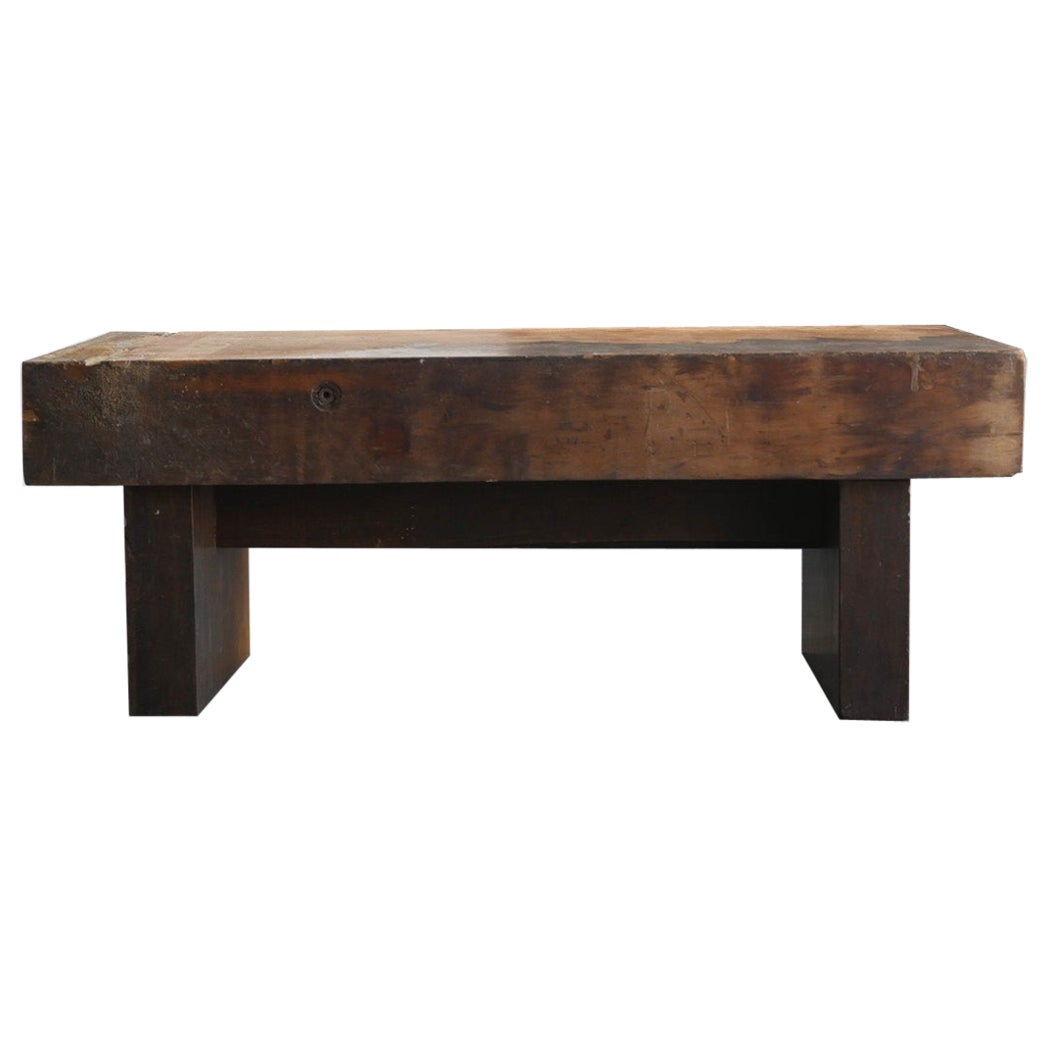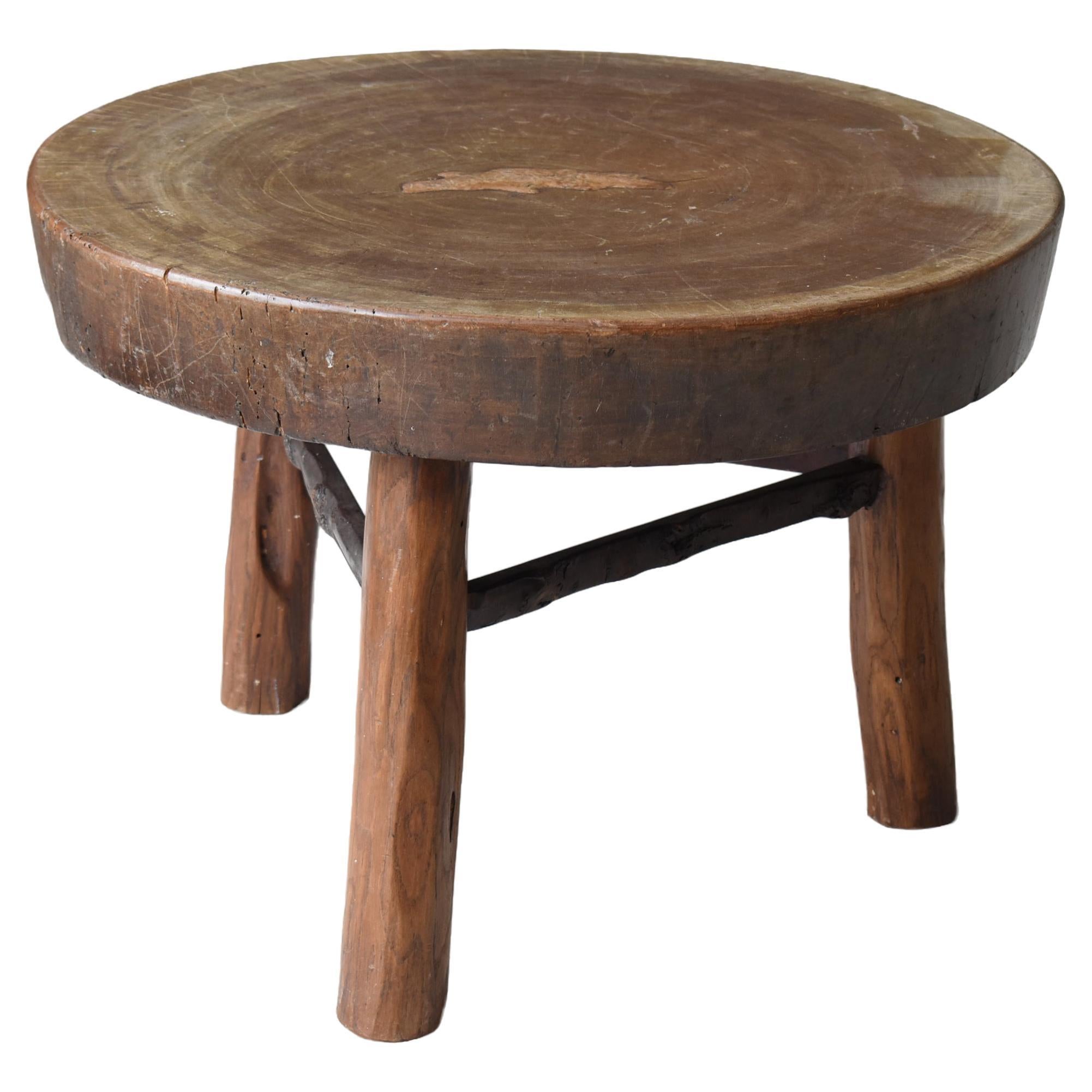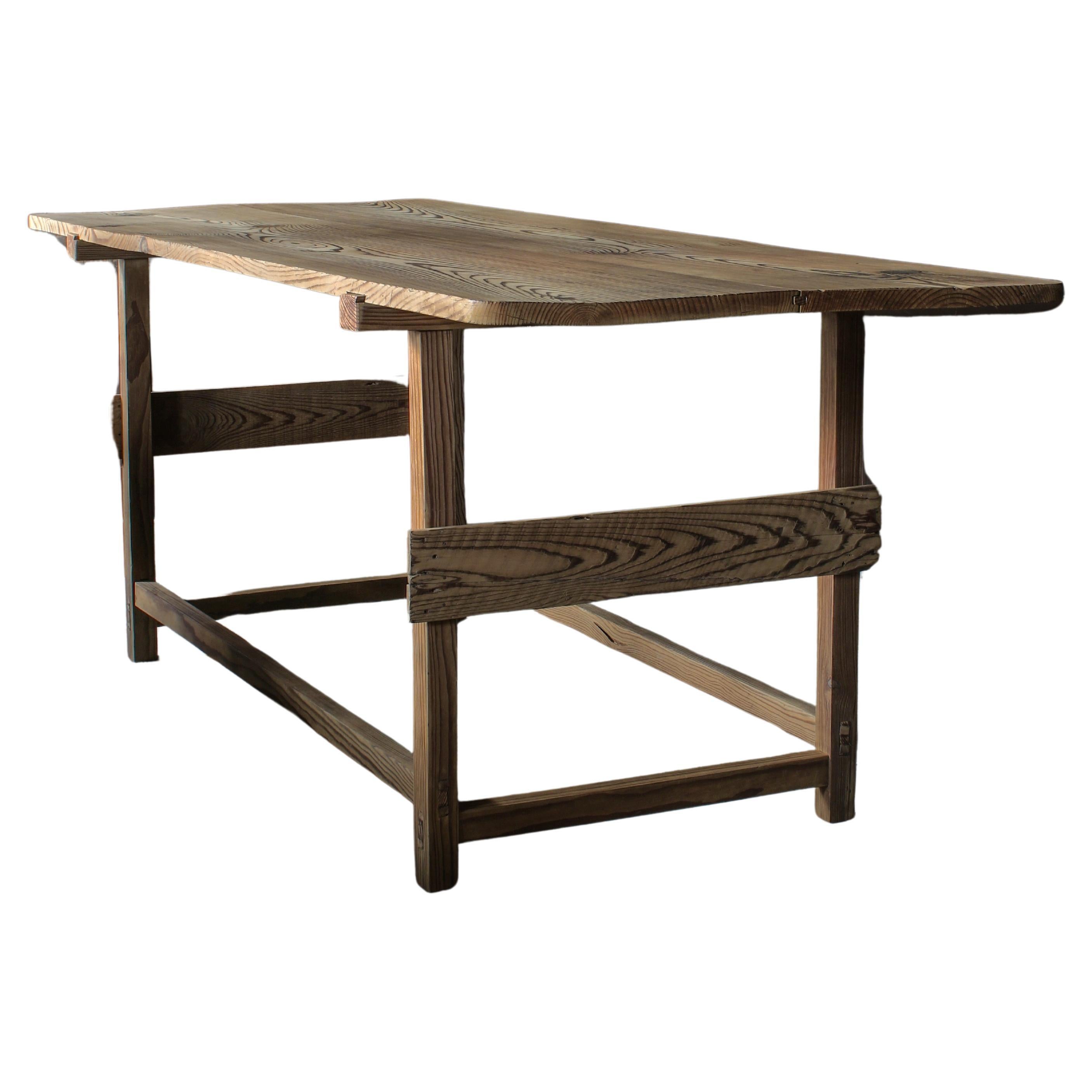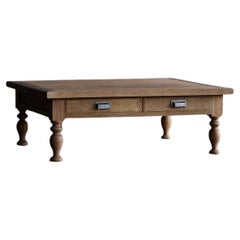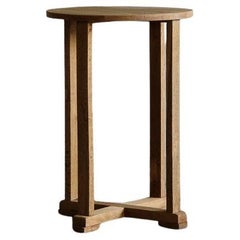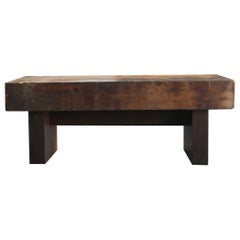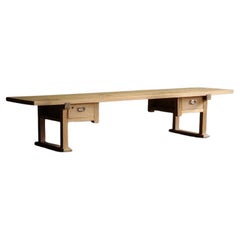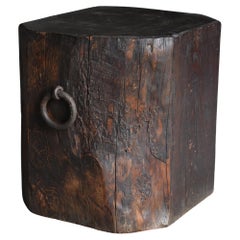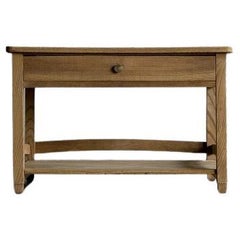Showa Tables
12
to
12
12
12
27,238
20,547
5,016
3,664
1,975
1,840
1,709
1,646
1,606
1,565
1,412
1,099
809
679
628
548
331
145
12
4
6
1
1
Height
to
Width
to
Depth
to
11
4
2
2
1
12
12
12
Style: Showa
Japanese Antique Wooden Table / Exhibition Table Early Showa Period Wabi Sabi
Located in Iwate-gun Shizukuishi-cho, Iwate Prefecture
It's an old table in Japan.
Cedar and pine are used for the materials.
It seems that it was made in a private house in the Tohoku region around the early Showa period.
Although it is a simple design, the Kumite part is assembled with a traditional technique that does not use nails.
The color that changed naturally over a long time and used is very beautiful, and it will complement the decoration as an exhibition table...
Category
Early 20th Century Japanese Showa Tables
Materials
Cedar
Japanese Antique Low Table, Early Showa Period '1926-'
Located in Hitachiomiya-shi, 08
This writing desk, crafted in the early Showa period(1926-) from high-quality Japanese zelkova and oak woods, is a testament to fine craftsmanship. The elegantly turned legs enhance ...
Category
Early 20th Century Japanese Showa Tables
Materials
Wood
Japanese Antique Round Table, Mid Showa Period '1926-'
Located in Hitachiomiya-shi, 08
This is a round table crafted in the mid-Showa period(1926-).
It is a slightly smaller size.
Made from high-quality, densely-grained Japanese oak, it is both durable and stylish. Its...
Category
Mid-20th Century Japanese Showa Tables
Materials
Wood
Japanese Antique Wooden Display Stand, Early Showa Period '1926-'
Located in Hitachiomiya-shi, 08
Discover the timeless elegance of this display stand, crafted in the early Showa period(1926-).
Its slender, turned legs showcase exquisite craftsmanship, instantly elevating any s...
Category
Early 20th Century Japanese Showa Tables
Materials
Wood
Japanese Antique Large Low Table 1900s-1940s / Sofa Table Wabi Sabi
Located in Sammu-shi, Chiba
Since ancient times, people have created necessary tools from familiar materials to survive in the severe struggle against nature, inherited them, and nurtured their lifestyle and cu...
Category
Mid-20th Century Japanese Showa Tables
Materials
Wood, Cedar
Japanese old wooden low table/1960/coffee table/wooden bench
Located in Sammu-shi, Chiba
I would like to introduce you to a very cool low table.
The top plate is an old work board used by Japanese craftsmen.
In addition, the table base is made from a work board used by c...
Category
Late 20th Century Japanese Showa Tables
Materials
Beech
Japanese Old Primitive Coffee Table 1940s-1960s / Round Table Mingei Wabisabi
Located in Sammu-shi, Chiba
Old primitive style round table made in Japan.
It was made in the mid-Showa period (1940s-1960s).
It consists only of a stump and tree branches.
The center of the tabletop is decor...
Category
1940s Japanese Vintage Showa Tables
Materials
Cedar
Japanese Antique, Set of two side tables, Early Showa Period'1926-', Wabi Sabi
Located in Hitachiomiya-shi, 08
This is set of two side table of Japanese antique.
It was made in the Showa period. (1926-)
This set of two side table is a gem that embodies both the traditional beauty of Japan an...
Category
Mid-20th Century Japanese Showa Tables
Materials
Wood
Japanese Antique, Side table, Showa Period'1926-', Wabi Sabi
Located in Hitachiomiya-shi, 08
This is a side table of Japanese antique.
It was made in the Showa period. (1926-)
This side table features a distinctive top design.
The hexagonal tabletop is made from finely textured Japanese kabazakura wood, highlighting its natural beauty. Furthermore, the radiating tapered legs are crafted from Japanese beech wood, offering both sturdiness and a polished look.
Ideal as an accent table in living or dining areas, it serves perfectly as a display stand for vases...
Category
Mid-20th Century Japanese Showa Tables
Materials
Beech, Birch
Thin Small Tray Made of Old Japanese Mulberry / Shop Card Holder / Tea Tray
Located in Sammu-shi, Chiba
Japanese old mulberry
Thin little tray made of / shop card holder / tea tray
A small tray made from old Japanese mulberry wood.
Mulberry is a high-class wood that has be...
Category
20th Century Japanese Showa Tables
Materials
Other
Japanese Antique Primitive Side Table 1900s-1940s / Stool Wabi Sabi
Located in Sammu-shi, Chiba
This is a very old stump side table made in Japan.
It is from the early Showa period (1920s to 1940s).
It is carved from a large cedar tree.
The iron ring on the handle is a nice, r...
Category
Mid-20th Century Japanese Showa Tables
Materials
Cedar
Japanese Antique Side Table, Early Showa Period 1920s
Located in Hitachiomiya-shi, 08
This is a Japanese antique side table.
It was made in the Early Showa Period 1920s.
This side table is an antique piece made in the early Showa period in Japan, entirely of Zelkova ...
Category
Early 20th Century Japanese Showa Tables
Materials
Wood
Related Items
Japanese Antique Wooden Low Table / Display stand / WabiSabi
Located in Iwate-gun Shizukuishi-cho, Iwate Prefecture
A exhibition stand made of old materials.
Probably, is the top board a zelkova and the legs an oak.
There is a very valuable wood grain, and it looks like an art created by nature....
Category
Mid-20th Century Japanese Showa Tables
Materials
Wood, Oak
Japanese Antique Cutting Board Low Table, Taisho Era'Early 1900s', Wabi Sabi
Located in Hitachiomiya-shi, 08
This is a Japanese antique cutting board low table.
It was made in the Taisho Era(1912-1926).
This low table was originally used as a work table...
Category
Early 20th Century Japanese Showa Tables
Materials
Cedar
H 11.23 in W 54.73 in D 14.38 in
19th C. French Charles X Restoration Period Sewing Stand Work Table
Located in Forney, TX
A scarce period Charles X (1818-1834) French Restoration mahogany travailleuse sewing (thread stand - side table - jewelry dressing table) with light, warm, beautifully aged patina.
Born in France in the early 19th century, almost certainly Parisian work, exquisitely hand-crafted, this exceptionally executed example features ornate gilt bronze ormolu mounts, escutcheons, and elaborate gilt metal trim. Having a highly figured light mahogany hinged lid top, lifting open to reveal a striking finished interior with divided compartments and original inset mirror plate. The conforming rectangular case fitted with a faux drawer front over a dovetailed drawer with sectioned interior. Elegantly rising on oval-shaped medial shelf stretcher-joined curvacious legs.
Dimensions (approx):
27" High, 20" Wide, 13.5" Deep
Stunning light almost blonde antique mahogany coloring and mellow warm tone, superb wood grain detail, and charming, beautifully aged patina over the whole. Great shape overall. Retaining original antique character marks, wear consistent with age and indicative of minimal use, nothing that detracts from the aesthetics or functionality, but only adds to the overall authenticity, refined elegant warmth, luxurious sophistication, and cozy unpretentious rustic elegance.
Delivered cleaned, hand waxed, polished French patina finish, ready for immediate use and generational enjoyment!
What is Charles X style:
The comte d’Artois – or Charles X - was the son of the dauphin Louis-Ferdinand de Franc and Marie-Josèphe de Saxe. He succeeded his two brothers Louis XVI and Louis XVIII and became the King of France in 1824. Thirty years after the French Revolution, he wanted to embody the return of monarchy and became the leader of the catholic party . As the previous kings, he was crowned in 1825 but he was soon overthrown by the revolution in July, 1830, called "Trois Glorieuses". He left then for England, Scotland, Prague and Istria where he died in 1836.
Charles X style lasted from 1818 to 1834 and happened during the Bourbon Restoration (French Restoration). This style did not replace totally the style of furniture from the French Empire but it was different from the formalism in the Napoleonic era, during which strictness and simplicity were inspired by Greco-Roman art. Indeed, artistic fields flourished. In terms of furniture, this renewal was suggested by the softening of shapes. Even though the simple aspect from the French Empire was still visible, shapes became curvier with volutes and arabesques. Another distinction is the loss of the massive aspect of furniture and the decrease of dimensions in order to decorate smaller appartments. Handling ability and comfort were key-words in the making of furniture. Apartments had essential elements such as chests of drawers, big rounded tables in the dining room, desks or secretaries, armoires and even dressing tables, comfortable fainting couches in the living room, small tables, pedestal tables, as well as gondola chairs. The wavy aspect of the latters certainly represent Charles X style the best.
One of the most emblematic features of this style is the use of bois clairs – light woods in warm blond tones - and indigenous woods that are varnished in order to highlight the grains. Bird's-eye maple, ash trees, plane trees, yew trees, beech trees, olive trees and cedar trees were most likely to be used. Indeed, at the beginning of the 19th century dark woods were hard to find. In 1806, the Napoleon’s Continental System was established in order to ruin the United Kingdom by preventing the country from any business with the rest of Europe. Therefore craftsmen had to find alternatives from mahogany which was the most commonly used material at this time. After 1815, the import of wood was even more difficult because of peace treaties and the European political situation, which contributed to the popularity of the bois clairs and indigenous woods. The furniture was often decorated with fine inlays made out of dark wood representing foliage, which contrasted with the veneer. Even though these patterns can look like bronze decorations from the Empire era, they were far more simple and did not represent any military or mythological attributes. On the tables, trays were sometimes made out of marble as in the French Empire, but it was often put aside and inlaid veneer, Verre Eglomisé – a type of glass with a mirror finish –, mirror or porcelain from Sèvres or Paris were more likely to be used.
Decorative elements from the Monarchy were highly appreciated again as they suggested luxury. Indeed, marquetry work was particularly fashionable - Boulle marquetry thrived around 1820 as the works of the Levasseur family can show. In the same way, draperies and trimmings referred to the monarchist splendour. Fabrics were often white – the traditional colour of the Bourbons – or light coloured as oppposed to the typical green from the Napoleonic era.
One of the most symbolic figures from this period of time might be Jean-Jacques Werner (1791-1849), a cabinetmaker who worked for prestigious clients such as the Duchesse de Berry who was Charles’s step-daughter. His works can be seen at the Musée des Arts Décoratifs and at the Grand Trianon in the Palace of Versailles. The duchess’s appartments situated at the pavillon de Marsan and at the Palais de Saint Cloud illustrate Charles X style the best with furniture made out of bois clairs and ornamented with dark wood patterns or fine gold decorations.
Chales X style allows a transition between the sobriety of the Empire style and the abundant aspect of Louis-Philippe style. The gothic style started at this time through the "style à la cathédrale", inspired by religious architecture, which thrived from 1827 to 1830. Indeed, at the beginning of the 19th century, Romanticism put the spotlight on the Middle Ages. Cabinetmakers were not inspired by the medieval furniture but rather by architectural elements of churches and cathedrals. For instance the backs of chairs were decorated with arches shaped like rib and serration. In the same way, before Charles X abdicated, pieces of furniture were made out of dark woods – such as mahogany, which was used again in France – and were inlaid with light wood. Romanticism also influenced the layout of furniture in appartments to suggest movement through a mix of various styles, various shapes and various sizes, as opposed to the static aspect of Neoclassicism. The start of industrialisation and mechanisation also influenced this style as early technical developments led to the production of pieces of furniture in series.
Credit:
Marc Maison
Bibliography:
FANIEL Stéphane (Dir.), Le Dix-neuvième Siècle Français, Collection Connaissance des Arts, 1957, Hachette
SASSONE, Adriana Boidi, Furniture from Rococo to Art Deco, 2000, Evergreen
--
Extremely versatile:
As warm and attractive as it is useful, this remarkable antique table having the ideal size and small proportions for a variety of different uses, including as a side table, accent or occasional table, tall sofa...
Category
Early 19th Century French Antique Showa Tables
Materials
Bronze, Ormolu
Wooden Table Rustic Farmhouse Coffee Pond
Located in Copenhagen, DK
Exploring fluid lines and featuring a sculptural shape, Farmhouse Coffee Table Pond represents a new, organic addition to Frama’s Permanent Collection...
Category
2010s Showa Tables
Materials
Oak
Midcentury Organic Wooden Scandinavian Wabi Sabi Coffee Table, Made in 1960s
Located in Odense, DK
Wonderful unique Scandinavian organic shaped coffee table in solid wood. This vintage piece is in good condition with some traces of wear.
A beautiful wabi sabi style brutalist ob...
Category
Mid-20th Century Scandinavian Showa Tables
Materials
Oak
H 13.39 in W 56.7 in D 27.56 in
Japanese antique wooden low table/early 20th century/coffee table
Located in Sammu-shi, Chiba
This is a low table that combines a Japanese antique wooden board and an antique wooden round stand.
The top plate is made of high-quality Japanese zelkova wood, and is thinly sliced...
Category
Early 20th Century Japanese Showa Tables
Materials
Wood
Antique American Early Kitchen Stove Now Console Table
Located in Forney, TX
A charming antique American kitchen range warming oven wood stove converted into a unique table with lots of storage!
Born around the turn of the late 19th / early 20th century, repurposed and fashioned it a one-of-a-kind table (or kitchen island) in the second half of the 20th century, having a divided top fitted with a later pair of glass panels over decorative cast iron burner hot plates, flanking an enameled hard work surface center, over patinated metal frame case fitted with two large cabinet doors featuring etched glass windows, well aged crackle paint and white porcelain pulls, opening to reveal a large and spacious single storage compartment in updated wood finished interior.
The old fashioned wood burning cooking stove with utilitarian rectangular shaped body, sculptural silhouette in early Art Deco taste with simple clean lines, smooth rounded edge and corners, single scrolling decorative element mounted on slated faux vent, rising on four substantial cast metal cabriole legs with stylized decoration. circa 1920
Versatile:
Finished on all sides so it can be placed anywhere in the room. Strong and sturdy, yet lightweight enough to easily move or put away when not in use, ideal size and proportions for a variety of different ways, including as use as a playful card games table, kitchen island, add chopping / cutting board and use as butcher block stand in a home, cafe or restaurant, breakfast buffet...
Category
Early 20th Century Showa Tables
Materials
Metal, Iron
Early 20th Century French Art Deco Period Iron and Metal Bistro Table
Located in Fayetteville, AR
This early twentieth century French Art Deco period rectangular bistro table or cafe table features a metal top on a cast iron pedestal base. ...
Category
Early 20th Century French Showa Tables
Materials
Metal, Iron
Antique Victorian quality mahogany large round dining table
Located in Ipswich, GB
Antique Victorian quality mahogany large round dining table having a quality large mahogany circular top with a moulded edge supported on a tu...
Category
Early 19th Century Antique Showa Tables
Materials
Mahogany
Antique Wooden Low Wabi-Sabi Style Plank Coffee Table
Located in London, GB
A long low coffee table.
France, c1930s.
Formed from antique wood into a new proposition.
Undulating natural wooden surface in wabi sabi style.
Stained finish.
Internal ref...
Category
1930s French Vintage Showa Tables
Materials
Wood
Japanese Antique Wooden Low Table / Coffee Table / 1912s-1926s / WabiSabi
Located in Iwate-gun Shizukuishi-cho, Iwate Prefecture
The top board is chestnut wood, and the legs are single-board lowtable with cedar.
The top board emphasizes the wood grain and expresses the flat surface beautifully and three-dimen...
Category
Early 20th Century Japanese Showa Tables
Materials
Wood, Chestnut, Cedar
H 13.39 in W 34.65 in D 22.45 in
Low Round Tricolumn Coffee Table by MSJ Furniture Studio
Located in Vancouver, BC
Our Tri-column Coffee Table is inspired by columns left behind by ancient Greek and Roman architecture. Consisting of a line of three columns and balanced on the opposite side with o...
Category
2010s Canadian Showa Tables
Materials
Beech
Previously Available Items
Japanese Antique Primitive Side Table 1900s-1940s / Stool Wabi Sabi
Located in Sammu-shi, Chiba
This is a very old stump side table made in Japan.
It is from the early Showa period (1920s to 1940s).
It is carved from a large cedar tree.
The iron ring on the handle is a nice, r...
Category
Mid-20th Century Japanese Showa Tables
Materials
Cedar
Japanese Antique Side Table, Early Showa Period 1920s
Located in Hitachiomiya-shi, 08
This is a Japanese antique side table.
It was made in the Early Showa Period 1920s.
This side table is an antique piece made in the early Showa period in Japan, entirely of Zelkova ...
Category
Early 20th Century Japanese Showa Tables
Materials
Wood
Japanese Antique Flower Stand 1920s-1940s / Side Table Wabi Sabi
Located in Sammu-shi, Chiba
This is an old flower stand made in Japan.
This furniture is from the early Showa period (1920s-1940s).
It is made of zelkova wood, which is very expensive nowadays.
The rustic and ...
Category
Mid-20th Century Japanese Showa Tables
Materials
Wood
Japanese Antique/Old Desk, Early to mid-Showa(1926-1955) Wabi Sabi
Located in Hitachiomiya-shi, 08
This is an old Japanese desk.
It was crafted in the early to mid Showa period.
The legs are made of Japanese cedar wood.
The top board is chestnut wood. It has grown into a beauti...
Category
1930s Japanese Vintage Showa Tables
Materials
Chestnut, Cedar
Japanese Antique Round Table, Mid Showa Period '1926-'
Located in Hitachiomiya-shi, 08
This is a Japanese antique round table.
It was made in the Mid Showa Period(1926-).
This Japanese antique round table features a design that pursues simplicity. The use of lauan for...
Category
Mid-20th Century Japanese Showa Tables
Materials
Wood
Japanese Old Round Coffee Table 1930s-1960s / Primitive Side Table Wabi Sabi
Located in Sammu-shi, Chiba
Old round coffee table made in Japan.
Simple design with stone pot and wood top.
This furniture is from the early Showa period (1930s-1960s).
T...
Category
Mid-20th Century Japanese Showa Tables
Materials
Stone
H 25.01 in W 28.35 in D 27.17 in
Japanese Antique Desk, Early Showa Period '1926-'
Located in Hitachiomiya-shi, 08
This antique desk, crafted in the Early Showa period of Japan.(1926-)
Explore our Japanese Antique Desk, meticulously crafted from cedar wood. With its distinctive and rare compact ...
Category
Early 20th Century Japanese Showa Tables
Materials
Cedar
Japanese Antique Tree Root Stand 1900s-1940s / Primitive Flower Stand Wabi Sabi
Located in Sammu-shi, Chiba
This is a very old tree root stand made in Japan.
It was made in the early Showa period (1900s-1940s).
The material is walnut.
It is a dynamic piece that allows you to fully appreci...
Category
Mid-20th Century Japanese Showa Tables
Materials
Walnut
H 32.49 in W 13.78 in D 13 in
Japanese Old Iron Exhibition Stand 1950s-1970s / Side Table Wabisabi
Located in Sammu-shi, Chiba
This is an old iron exibition stand made in Japan.
This furniture is from the mid-Showa period (1950s-1970s).
What it was made for and its use is not known at all.
However, it is a ...
Category
1950s Japanese Vintage Showa Tables
Materials
Iron
Japanese antique table / wood side table wabi-sabi exhibition stand
Located in Sammu-shi, Chiba
This is an exhibition stand with tree branches attached to a birch stump as legs.
The bark of the tree is still attached to the stump, giving it a sense o...
Category
Mid-20th Century Japanese Showa Tables
Materials
Birch
Japanese antique table / 1900〜 side table & coffee table
Located in Sammu-shi, Chiba
A table made from an old Japanese mortar (a container used for pounding grain and rice cake with a pestle. Things are placed inside the mortar).
The table was made by fitting a black...
Category
Mid-20th Century Japanese Showa Tables
Materials
Wood
Japanese antique round table "Chabudai" / cocktail table / early Showa 1920's
Located in Hitachiomiya-shi, 08
This antique table is a low table made during the Taisho era or the early Showa period. It is a traditional Japanese "Chabudai."
The legs, with their classical ambiance, are crafted from luxurious zelkova wood, highlighting both durability and beauty.
The round tabletop, made from a single piece of chestnut wood, captivates with its natural texture and grain. Additionally, the underside of the top is reinforced with metal brackets (kasugai), which prevent splitting and add a unique antique charm...
Category
Early 20th Century Japanese Showa Tables
Materials
Chestnut
Showa tables for sale on 1stDibs.
Find a broad range of unique Showa tables for sale on 1stDibs. Many of these items were first offered in the Mid-20th Century, but contemporary artisans have continued to produce works inspired by this style. If you’re looking to add vintage tables created in this style to your space, the works available on 1stDibs include tables, serveware, ceramics, silver and glass and other home furnishings, frequently crafted with wood, birch and other materials. If you’re shopping for used Showa tables made in a specific country, there are Asia, East Asia, and Japan pieces for sale on 1stDibs. It’s true that these talented designers have at times inspired knockoffs, but our experienced specialists have partnered with only top vetted sellers to offer authentic pieces that come with a buyer protection guarantee. Prices for tables differ depending upon multiple factors, including designer, materials, construction methods, condition and provenance. On 1stDibs, the price for these items starts at $500 and tops out at $1,700 while the average work can sell for $960.
Recently Viewed
View AllMore Ways To Browse
Antique Glass Round Table
Chrome Dining Table And Chairs Set
Antique Round Glass Table
Here I Sit
Antique French Dressing Tables
Antique French Dressing Table
Kitchen Table Original Paint
French Dressing Table Antique
French Antique Dressing Table
French Antique Dressing Tables
Vintage Architectural Dining Table
Kitchen Table Round Modern
Large French Country Dining Table
Mid Century Modern Chinese Tables
Mid 20th Italian Trolley Bar Carts
Antique Wood Urn
Small Sitting Room Table
Vintage Italian Cart
